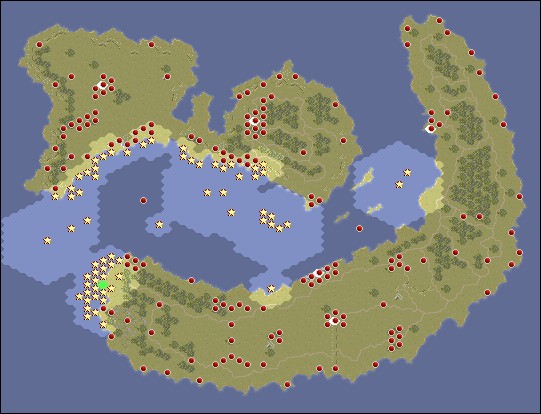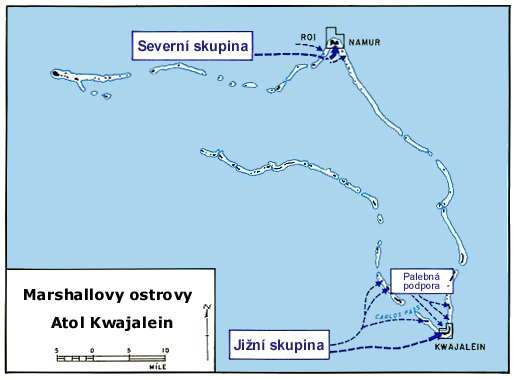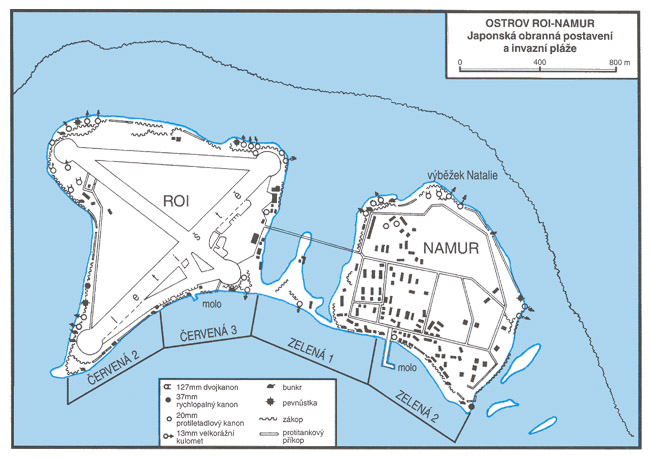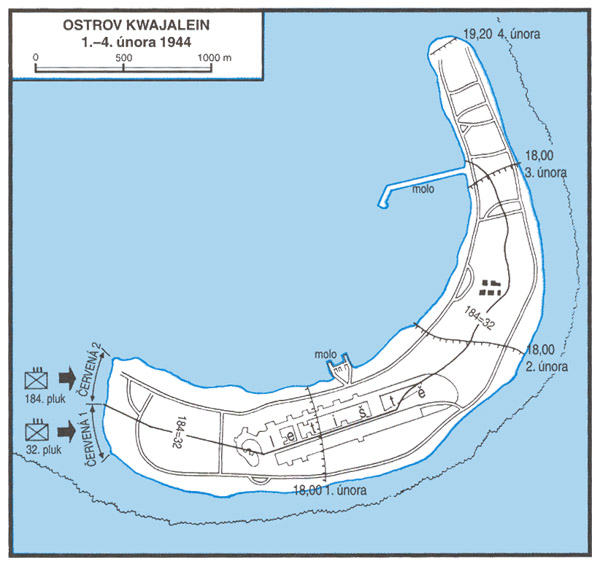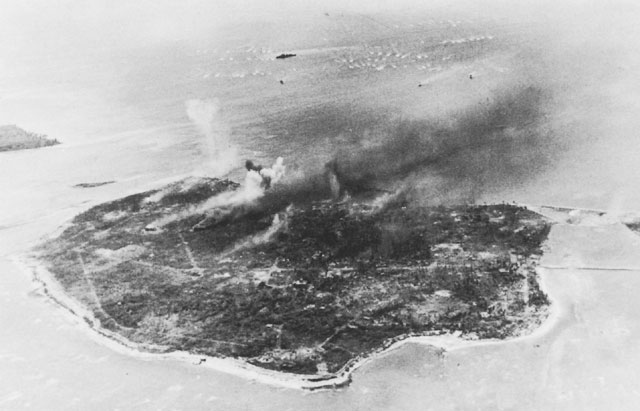| Operation codename: Flintlock |
Admiral Nimitz had the opinion that there is not need to delay, disperse power and increase the losses by an attack on the Mille, Moloelap, Wotje and Jaluit atolls after a very good experience with tactics "frog jumps" from the South and Southwest Pacific and it is preferable to bypass and isolate the enemy positions and attack directly the most important bases throughout the archipelago, the islands of Kwajalein and Roi-Namur, located in the Kwajalein Atoll. (Miloš Hubáček - Ofenziva v Pacifiku, Mladá fronta, 2000)
Article on Czech Wikipedia (1)
Article on Czech Wikipedia (2)
Article on English Wikipedia| Scenario in dates: |
| December 29, 1941: |
Marshall Islands - Japanese submarine Ro-60 loses its orientation in night bad weather and runs aground on the Kwajalein Reef. After arrival of the submarine tender Jingei, due to fatal damage, the entire crew is boarded and the vessel abandoned. The half-protruding wreck would crumble decades after the war. |
| February 1, 1942: |
In the Pacific - Under the command of Admiral Halsey and Fletcher, American task forces attack Japanese held air bases in the Marshall and Gilbert Island. The US aircraft carrier USS Enterprise (CV-6) is damaged during the attacks. |
| August 11, 1943: |
Central Pacific - US Army defense forces occupy remote, deserted Baker Island in preparation for a campaign against the Gilbert and Marshall Islands. Construction of an airfield for B-24 bombers and P-40 fighters begins immediately. |
| August 25, 1943: |
In the United States - In Camp Elliot, California, the V Amphibious Corps is formed, the core of which is the three Divisions of the Marine Corps (3rd, 4th, and 5th), and becomes the striking amphibious force of the 5th Fleet. Headed by one of the most competent, General Holland McTyeire Smith. It is the commander who since the outbreak of war directed extensive training of the US Army, Navy and Marines in amphibious combat, which subsequently became the main factor of successful American landings in the Pacific and Atlantic. The corps under his leadership will gradually conquer the Gilbert, Marshall and Marian Islands, eventually Iwo Jima and General Smith will retire after the war, recognized a the "father" of modern U.S. amphibious warfare. |
| December 4, 1943: |
In the Marshall Islands - Task Force 50 (Admiral Pownall) and a task force commanded by Admiral Montgomery attack Kwajalein with a combined fleet of 6 carriers and nine cruisers. The Japanese lose 6 transports and 2 cruisers are damaged. A claimed 55 Japanese aircraft are shot down for the loss of 5 attacking American planes. The USS Yorktown (CV-10) conducts an air raid on Wotje. |
| December 8, 1943: |
In the Marshall Islands - Kwajalein is bombarded by an American force consisting of 5 battleships and 12 destroyers commanded by Admiral Lee. One Japanese destroyer is damaged. |
| January 29, 1944: |
In the Marshall Islands - US Task Force 58 (Admiral Mitscher) bombs and shells Japanese targets on Roi, Namur, Maloelap and Wotje. American land-based aircraft bomb Jaluit and Mille. |
| January 30, 1944: |
In the Marshall Islands - US Task Force 58 continues the bombardment of Kwajalein, Roi, Namur and Eniwetok. There are 7 battleships involved and 400 bombing sorties are flown. |
| January 31, 1944: |
In the Marshall Islands - American landings begin on the islands of Kwajalein Atoll. Admiral Spruance is in overall command and General Holland Smith commands the various landing forces. Elements of US 4th Marine Division (Smith) land on Roi, Namur and nearby islets. Task Force 53 (Admiral Connolly) provides transport and naval support, including battleships and escort carriers. The landing on Roi makes rapid progress. On Namur there is heavy Japanese resistance. Meanwhile, there are also landings on Majuro Atoll by the US 27th Infantry Regiment. Admiral Hill´s task force provides naval support. The Majuro Atoll is captured quickly and is immediately prepared to become a base for American forces. Also, the carriers of Task Force 58 (Admiral Mitscher) continue attacks on Eniwetok and Maleolap. |
| February 1, 1944: |
In the Marshall Islands - American operations against the Kwajalein Atoll continue. On Roi US forces are mopping up. There is heavy fighting on Namur, in which Private Richard K. Sorenson distinguishes himself - he throws himself at an enemy grenade (coincidentally of American production, coming from supplies captured by the Japanese on Bataan) to save his comrades with his body. However, he survives the subsequent severe injuries. During the entire war, only four Marines survive such an act and receive the Media of Honor for it. Private Stephen Hopkins, the 18-year-old son of President Roosevelt´s closest adviser, Harry Hopkins, dies after a brave fight on Namur. US Task Force 52 (Admiral Turner) provides naval support for the landing of the 7th Infantry Division (General Corlett) on Kwajalein. Here, the Americans overrun a third of island, despite heavy Japanese resistance. The American battleships USS Washington (BB-56) and USS Indiana (BB-58) collide in the night darkness. Both vessels are sent to Pearl Harbor to repair serious damage. |
| February 2, 1944: |
In the Marshall Islands - Battles continue in the Kwajalein Atoll. American forces complete the conquest of Roi and Namur. Almost all of the 3700 Japanese defenders on these islands have been killed. American casualties number 740 killed and wounded. Japanese forces on Kwajalein continue to resist. |
| February 3, 1944: |
In the Marshall Islands - US Task Group 58.4 (Admiral Ginder) raids Eniwetok with its carrier aircraft. In the Kwajalein Atoll, American forces land on Burton Island. |
| February 4, 1944: |
In the Marshall Islands - Organized Japanese resistance in the Kwajalein Atoll ends. Most of the 8700 Japanese garrison commanded by Admiral Akiyama Monzo have been killed. Only 265 are captured, many are Korean laborers or wounded. The Americans have deployed 41,000 troops of whom 370 have been killed in action and 1500 wounded. |
| February 7, 1944: |
In the Marshall Islands - In the Kwajalein Atoll, American forces complete the elimination of isolated Japanese pockets of resistance. |
| February 12, 1944: |
In the Marshall Islands - There are American landings on Arno Atoll. |
| February 16, 1944: |
In the Marshall Islands - Carrier aircrafts from US Task Group 58.4 (Admiral Ginder) with Saratoga (CV-3), USS Princeton (CVL-23) a USS Langley (CVL-27) raid Eniwetok. The Japanese airfield on Engebi is no longer operational. |
| February 17, 1944: |
In the Marshall Islands - US forces land on Eniwetok Atoll. Task Force 51.11 (Admiral Hill) lands small parties on Canna and Camelia islets near Engebi with artillery to cover later operations. There are 3 battleships and 3 escort carriers providing naval support. The Japanese garrison of the atoll consists of about 3400 troops commanded by General Mushida. |
| February 18, 1944: |
In the Marshall Islands - In the Eniwetok Atoll, American forces land Engebi and establish a beachhead. The invasion is supported by land-based artillery from day before occupied istets, as well as naval and air bombardments. Japanese counterattacks are defeated. |
| February 19, 1944: |
In the Marshall Islands - Fighting continues on Engebi in the Eniwetok Atoll. Americans land on Eniwetok in regimental strength. There is heavy Japanese resistance, in spite of massive preparatory bombardments. |
| February 20, 1944: |
In the Marshall Islands - American carrier aircrafts from Task Group 58.1 (Admiral Reeves) attack Japanese targets in Jaluit Atoll. The fighting on Eniwetok continues. The nearby island of Parry is shelled by US naval forces. |
| February 22, 1944: |
In the Marshall Islands - US forces land on Parry Island, in the Eniwetok Atoll. There is heavy Japanese resistance. |
| March 12, 1944: |
In the Marshall Islands - Americans occupy Wotho Atoll. There is no Japanese garrison. |
| May 17, 1945: |
In the Marshall Islands - Aircraft from the USS Ticonderoga attack targets on the Japanese held island of Taroa at the Maleolap Atoll, encountering limited resistance. |
| August 22, 1945: |
In the Marshal Islands - The Japanese garrison on Mili Atoll capitulated in a ceremony on an American destroyer escort USS Levy (DE-162). This is the first time a Japanese force surrenders en masse. |
| January 29, 1946: |
United States - Harry Lloyd Hopkins, an American statesman and prominent public figure, dies of stomach cancer in New York. During the war, he was President Roosevelt´s closest adviser, a key figure in US foreign policy and administrator of the Lend-Lease program. Despite his health problems, in the first weeks he was also a major support for the new President Truman, who was still inexperienced in foreign policy issues. Harry Hopkins, survived President Roosevelt for less than a year and survived his son Stephen Hopkins, who fell as a Marine in the battle of Namur Island in Kwajalein Atoll in the Marshall Islands at the age of 18. |
| December 22, 1946: |
Marshall Islands - German heavy cruiser Prinz Eugen, which survived the American Able and Baker nuclear tests as war booty in July, capsizes and sinks at Kwajalein Atoll, where he was towed to after the tests. |
|
| Literature sources: |  | Jordan, David, Wiest Andrew: Atlas Of World War II., Ottovo nakladatelství, 2006, Praha |  | Moskin, J. Robert: The U.S. marine corps story, Laser - books, 1997, Plzeň |  . . | Swanston, Alexander & Malcolm: The Historical Atlas of World War II, Columbus, 2007, Praha |  . . | Šnajdr, Miroslav: Flying Marines, Akcent, 2015, Třebíč |  | Pejčoch, Ivo: Obrněná technika 10 (Armored machinery 10), Ares, 2010, Praha |  | Hubáček, Miloš: Ofenzíva v Pacifiku (Offensive in Pacific), Mladá fronta, 2000, Praha |  | Kolektiv, : War in the Pacific, Naše vojsko, 2006, Praha |  | Hrbek, Jaroslav, Hrbek Ivan: Vítězství přichází z moře (Victory comes from sea), Naše vojsko, 1999, Praha | Pejčoch, Ivo: Ka-Mi, HPM No. 2/2005
|
|
